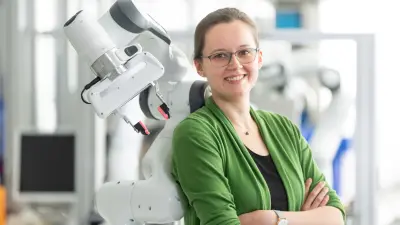Dr. Felix Hildebrand
Senior Expert AI-enabled Hybrid Modeling for Component Design

I am working as a research engineer on computational material modeling on different scales. My current focus is on the intersection between physical modeling and artificial intelligence (AI). The overall question in this process is how these two approaches can best be combined to "hybrid" methods. The goal is to substantially improve our products through faster and more precise models.
Please tell us what fascinates you most about research.
For me, research is about finding new solutions. On the path to these solutions, one has to deal with new, exciting and often surprising questions, take detours and face dead ends, and do all of this with a combination of curiosity, creativity and persistence. Research is never boring, you always keep on learning, meeting inspiring people and feeling the pulse of time. And it is a great satisfaction if the identified solutions end up improving one of our products.
What makes research done at Bosch so special?
For me, research at Bosch is special as it combines both width and depth: On the one hand, researchers from a large number of scientific disciplines work together on a broad spectrum of technically challenging products. Depending on the problem at hand, they form interdisciplinary teams. On the other hand, we do not hesitate to tackle large and very complex questions if they are decisive for the success of our products.
What research topics are you currently working on at Bosch?
The focus of my research is the question of how domain knowledge as material models, for example, can best be combined with AI in the field of computational materials science. One related challenge is the automatic processing of materials science texts with the help of AI that takes advantage of domain knowledge. Another application is "hybrid" material models that combine AI-based and physically based modeling approaches.
What are the biggest scientific challenges in your field of research?
Despite intense research in both the areas of computational material modeling and AI and the constant huge progress in both fields, research at the intersection of both disciplines is relatively young. This includes the hybrid methods that combine extensive domain knowledge with AI. The big question is how such hybrid methods should be designed under given conditions to achieve an optimal synergy.
How do the results of your research become part of solutions “Invented for life”?
Methods such as hybrid material modeling have the overall goal of allowing faster and more accurate predictions of the behavior of existing as well as new, disruptive materials in our products. Such predictions substantially simplify and accelerate the design of innovative products with improved or completely new functionality and higher reliability. They thus enable us to provide new and better products to our customers much faster.
Curriculum vitae
2013
Ph.D. at the Institute of Applied Mechanics with Christian Miehe, University of Stuttgart
2008
Research assistant at the Center of Mechanics with Sanjay Govindjee, ETH Zurich
2006
Visiting student at the Department of Mechanical Engineering with Rohan Abeyaratne, Massachusetts Institute of Technology

Selected publications

M. Ganser et al. (2019)
- M. Ganser, F.E. Hildebrand, M. Kamlah, R.M. McMeeking
- Journal of the Mechanics and Physics of Solids 125, 681-713

M. Ganser et al. (2019)
- M. Ganser, F.E. Hildebrand, M. Klinsmann, M. Hanauer, M. Kamlah, R.M. McMeeking
- Journal of The Electrochemical Society 166 (4), H167-H176

R.M. McMeeking et al. (2019)
- R.M. McMeeking, M. Ganser, M. Klinsmann, F.E. Hildebrand
- Journal of The Electrochemical Society 166(6) A984-A995

M. Mykhaylov et al. (2019)
- M. Mykhaylov, M. Ganser, M. Klinsmann, F.E. Hildebrand, I. Guz, R.M. McMeeking
- Journal of the Mechanics and Physics of Solids 123, 207-221
Get in touch with me
Dr. Felix Hildebrand
Senior Expert AI-enabled Hybrid Modeling for Component Design



